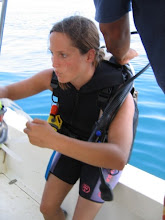So good news everyone: my lungs didn’t explode! How great is that? Actually, it turned out to be an amazing experience. I’ve actually decided me favorite place in
Anyway, so how does one go about getting certified? Well, on Friday we left for Playa Hermosa (
On Saturday we woke up bright and early to start exploring the pool. But before we could learn to dive, we had to learn how to use the gear. When diving you wear a wet suit, a weight belt, flippers, a mask, and of course, a tank full of oxygen with 3 hoses coming out of it. The three hoses provide air to you, to others (if necessary), and to the vest because you need to fill it with air to float. We learned in the pool first to get used to the regulator (the breathing apparatus) and the buoyancy controls. We all got in a circle and we had to practice taking our regulators out and then putting them back in, using other people’s octopuses (an extra regulator attached to your air tank, used to share oxygen with people if they run out), and taking our masks (goggles) off. Taking the goggles off scared me a little. To get the water out of the mask you push on the top part of it, tilt your head back, and blow air out of your nose. I hate getting water in my eyes, and I definitely hate having a plastic thing full of water suctioned to my head. I did it, and I got some water up my nose and my eyes hurt a little, but I did it without going to the surface.
That afternoon we went to the ocean. Only 6 of us went down at a time (there were 10 total) because we only had one instructor. Dan was my partner, so we were in charge of looking after one another. I won’t lie, I was a little nervous. However, we only went into water that was about 20 feet deep, so you could come to the surface at anytime. We swam through a massive school of fish, and we saw tons of blow fish and many other kinds of tropical fish. We also saw eels and an octopus. I filled up my whole 27 exposure, waterproof camera. So I’m hoping some of those pictures turn out. That dive lasted about 50 minutes. When you start, your air tank has about 3000 psi of air pressure, and you have to come up when someone gets down to 1000 psi.
On Sunday we took a boat out to an island. On the way there we saw “something” whales (I’m so specific, I know), which are actually a type of dolphin. Anyway, we got to the island and all 12 of us went down at the same time. This time we went down to about 50 feet. Some people had problems adjusting their ears to the pressure, but I could swim straight down, fortunately. I just had to keep swallowing. On this dive we saw a sea turtle, which I would estimate (although water distorts the distance and size of objects) was about 3 feet long. It was a Green Sea Turtle, and when people tried to touch it, the guides banged metal snaps on their air tanks and shook their heads no.
We were on the bottom for about 30 minutes for that dive.
On the surface we had to wait 40 minutes before we could go back down. This has something to do with letting your body adjust to the pressure, or air, or something again. I should probably know this since I’m technically certified, but I guess I’ll play it safe and go with guides, or I’ll have to study a bit before I go down on my own. During the 40 minute break, some of us swam to the island and went into a shallow inlet/cave thing. There were hundreds of crabs all over the rocks, and when you got near they just dove to safety into the ocean. It was pretty cool except one of the girls sliced open her foot on the island because it was made out of coral type stuff and was very sharp.
Anyway, we put our tanks back together, got our gear on and went back down. I was one of the first people down, and when we got to the bottom,
On this dive, we saw mostly the same animals again. However, there were trumpet fish that were about 3 feet long, 2 inches wide, and almost transparent. I also saw big eels. I think they’re called moray eels, or something similar to that. The guide told me to stick my fingers by its mouth (as a joke, obviously), but I’m not dumb. I’ve watched “The Little Mermaid” enough times to know better than that.
Anyway, this time they decided to only take people up when their oxygen was running low, and since I was one of the first people down (and I did breathe rather heavily during the goggle incident) I had to go up after only 35 minutes.
Even though I love air, and I think there are many beautiful places above sea level, there’s something spectacular about the sea floor. It really is a completely different world. It looks like everything is flying, and you can even fly yourself. You just fly through the water in a world that you don’t belong to, but for 35 short minutes you can. So if there is anyone else out there who watched “The Little Mermaid” as many times as I did or just really loves water, I definitely recommend scuba diving. It’s definitely worth it, even if you do get a little salt water in your eyes.




